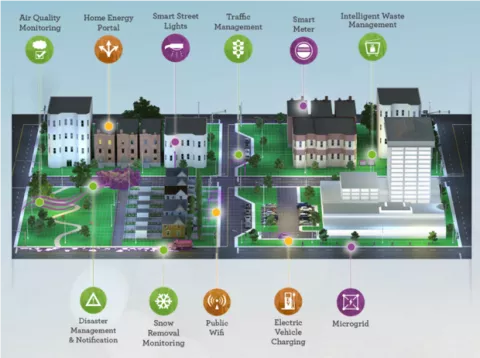
by Jason Nelson
For years, the Smart Cities Council has been advocating smart, shared infrastructure. We urge cities to install systems that can eventually be used for many city functions, even if they initially serve only one department. No government can gain the full benefits of a smart city through piecemeal, isolated projects. And no government can afford digital transformation unless it shares technology, shares data, and shares costs between departments.
Although many cities are now taking this approach, some of the best real-world examples come from electric power utilities. Below are two cases from the United States. Both electric companies embarked on a long-term plan to upgrade their digital infrastructure. And then they began layering more and more applications on top of that platform. Best of all, both electric companies are sharing the benefits – and, in some cases, sharing the infrastructure itself – with the communities in their service territories.
Commonwealth Edison
Commonwealth Edison (ComEd) provides electrical service to more than 4 million customers in Chicago and northern Illinois. It is now underway on a 10-year, $2.6 billion infrastructure investment plan, investing $1.3 billion to strengthen its electric system and another $1.3 billion to add new smart grid technology.
ComEd is leveraging a common network for multiple applications, including advanced metering infrastructure (AMI), distribution automation (DA), and smart city programs. With a modernized communications infrastructure, the utility is able to increase grid reliability by identifying problems faster, optimizing business processes, automating problem resolution and reducing truck rolls.
ComEd chose Itron’s end-to end IPv6 network platform for deployment to all 4 million customers. By relying on a standards-based foundation, ComEd can easily integrate future technologies and applications. Increased business efficiencies expected from the project include a targeted reduction of $30 million in uncollectible expense, a 90% reduction in consumption of inactive meters and a 50% reduction in unaccounted energy use.
ComEd has identified the following outcomes as a result of its grid modernization initiative so far:
- 65% cost reduction for streetlight energy usage
- $100M in operational cost reductions returned to customers each year
- More than 7.1M customer interruptions avoided (since 2012)
- 48% reduction in outage duration
- $1.4 billion in societal savings from avoided outages
Florida Power & Light
Florida Power & Light (FPL) is deploying North America’s largest networked street lighting program to connect and control more than 500,000 streetlights. By automating management and delivering more precise outage information, networked street lighting can increase operational savings by reducing the need for mobile crews.
FPL is also using Itron’s IPv6-based network. It is leveraging the same network for multiple applications, including advanced metering, distribution automation, and smart streetlights. It has reduced call center load, enabled faster outage restoration, and improved and network performance. The overall benefits include:
- 5.1 million customer interruption minutes avoided per year
- $46 million estimated annual OPEX savings
- 25% improvement in service reliability since 2010
- 10,000 customer outages avoided by detecting transformer issues in advance
- 100,000 avoided field visits
- Accelerated service restoration for streetlights



